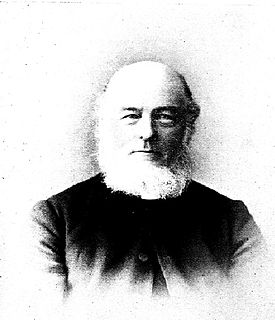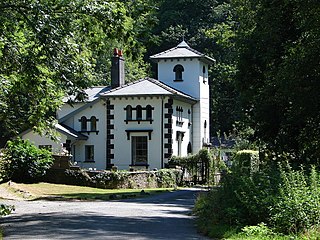
The Diocese of Saint Asaph is a diocese of the Church in Wales in north-east Wales, named after Saint Asaph, its second bishop.

Berriew is a village, community and electoral ward in Montgomeryshire, Powys, Wales, on the Montgomeryshire Canal and the Afon Rhiw near the confluence with the River Severn at grid reference SJ185005, 79 miles (128 km) from Cardiff and 151 miles (243 km) from London.

Pontrobert is an ecclesiastical parish that was formed in September 1854. It comprises the townships of Teirtref and part of Nantymerchiard in the parish Meifod, a portion of Cynhinfa which was in the parish of Llangynyw and portions of the townships of Fachwel, Llaethbwlch and Cadwnfa which were in the parish of Llanfihangel. The total area of this parish is 5,000 acres. As a result of this arrangement, Pont Robert is now divided between the present day Community Councils of Meifod, Llangyniew and Mawddwy. Pontrobert was within the historic county of Montgomeryshire, now forming part of Powys. The name Pontrobert is derived from Robert ap Oliver of Cyhinfa, who built the original bridge over the River Vyrnwy around 1700. An alternative Welsh name for Pontrobert is Pont y ddolfeiniog.

The Bishop of St Asaph heads the Church in Wales diocese of St Asaph.
The office of High Sheriff of Montgomeryshire was established in 1541 since when a High Sheriff was appointed annually until 1974 when the office was transformed into that of High Sheriff of Powys as part of the creation of Powys from the amalgamation of Montgomeryshire, Radnorshire and Brecknockshire. Between the Edwardian Conquest of Wales in 1282 and the establishment of the High Sheriff of Montgomeryshire in 1541 the sheriff's duties were mainly the responsibility of the coroner and the Custos Rotulorum of Montgomeryshire. The Office of High Sheriff remained first in precedence in the County until the reign of Edward VII when an Order in Council in 1908 gave the Lord Lieutenant of Montgomeryshire the prime Office under the Crown as the Sovereign's personal representative.
David Powel was a Welsh Church of England clergyman and historian who published the first printed history of Wales in 1584.
Robert Wynne was a Welsh cleric and academic.
John Pryce was a Welsh clergyman and writer on church history, who became Dean of Bangor Cathedral.
Thomas Thomas was a Welsh Anglican clergyman. He was noted for his parish ministry in Caernarfon, particularly for his educational work in building schools and helping to found the North Wales Training College.

Henry Parry was a Welsh clergyman and antiquarian.

Selattyn is the name of a village close to Oswestry in Shropshire, England, on the England–Wales border.

Rowland Williams was a Welsh Anglican priest and writer.
Walter Davies, commonly known by his bardic name Gwallter Mechain, was a Welsh poet, editor, translator, antiquary and Anglican clergyman.
Dr Richard Gwent was a prominent lawyer and senior churchman of Welsh origins, very active in London during the later reign of King Henry VIII. He was Archdeacon of London from 1534 until his death.

Rev. Elias Owen MA, F.S.A. was a Welsh cleric and antiquarian whose works include The Old Stone Crosses of the Vale of Clwyd, 1886 and Welsh Folk-Lore, 1896.
Archdeaconry of Montgomery. An Archdeaconry within the Diocese of St Asaph. It covers the eastern area of Montgomeryshire and includes Welshpool, Newtown, and Llanfyllin. Originally part of the Archdeaconry of Powys, which dated from the Medieval period. The Archdeaconry of Powys was reconstituted by an Order in Council in 1844, when it was split into the Archdeaconry of Montgomery and the Archdeaconry of St Asaph. In recent years the Archdeacon has lived in 17th century half-timbered Vicarage at Berriew. .

St Michael’s Church is the parish church of Kerry, in the historic county of Montgomeryshire, now Powys. Kerry is sited about 3 miles to the S E of Newtown. which suggests that there may have been a church on the site since the 7th century. The church stands in an almost oval churchyard in the centre of the village. It was rebuilt and re-dedicated in 1176. Of the original church only the north aisle arcade survives, and the chancel arcade is 14th-century in date. The square stone tower is surmounted by a Montgomeryshire style timber-framed belfry. The main body of the church was rebuilt in 1882–83 by the architect George Edmund Street, paid for by James Walton of Dolforgan Hall.

Richard Kyrke Penson or R. K. Penson was a Welsh architect and artist.
David ab Owen was a Welsh abbot and bishop. His family were from the Glasgoed area of Meifod, Montgomeryshire. He studied at Oxford, graduating with a qualification in Canon and Civil Law. He is thought to have taken his Doctorate in Law.
















